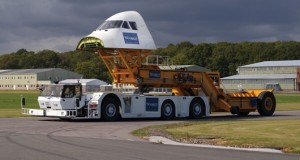
Ricardo's TaxiBot prototype in action.
Normally an airliner is pushed back from the gate with an airplane tug. Once the aircraft is cleared of any obstacles, the tug disconnects and the aircraft moves on its own power down the taxi way and takes off. When there are back ups on the taxi ways, airlines waste fuel and create additional pollution into the atmosphere.
According to research done by Airbus and Israel Aerospace Industries, taxiing at airports will cost about $7billion per year by 2012, will release about 18 metric tones of CO2 per year, and create about $350million per year in debris damage.
Things might change in the future. Ricardo, an engineering company, has successfully created a new tug called “TaxiBot” that connects to an airplane’s wheels, and pulls the aircraft around the airport. The TaxiBot uses the plane’s breaks, but uses its own power, allowing the jet to save fuel.
Ricardo CEO Dave Shemmans said, “We are extremely pleased to have been able to play such a central role in the development of this innovative concept which could dramatically reduce the CO2 emissions of commercial aviation while improving air quality and reducing noise pollution in the vicinity of the world’s major airports.”
Since the TaxiBot has shown its potential, Airbus and ground support equipment provider TLD have agree to help in the next stages of development. The TaxiBot currently requires a driver, but in future designs, it will be operated by the pilot of the plane.
follow via | web | twitter | email | rss |
Source: Ricardo via Gadling